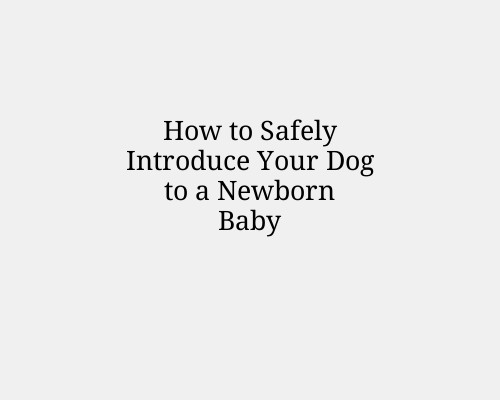
How to Safely Introduce Your Dog to a Newborn Baby
Bringing a newborn baby home is a life-changing experience—not just for the parents, but for the family dog as well. Dogs are creatures of habit, and any sudden shift in routine, attention, or environment can be stressful. The good news is that with careful preparation and management, your dog can adapt well to the new arrival and become a loving, protective companion. Here’s a comprehensive, beginner-friendly guide on how to safely introduce your dog to a newborn baby.
Start Preparing Early in the Pregnancy
Reinforce Basic Commands
Before the baby arrives, ensure your dog reliably responds to basic commands like sit, stay, leave it, down, and go to bed. These commands help manage your dog’s behaviour in the presence of a newborn.
Gradually Adjust the Routine
Babies change your schedule. Begin shifting your dog’s feeding, walking, and playtime routines to reflect the expected baby schedule. This softens the shock when the baby comes home and your time is divided.
Desensitize to Baby Sounds
Play recordings of crying babies and other infant sounds at increasing volume levels. Pair the sounds with treats and praise so your dog builds positive associations.
Set Up the Baby’s Space
Allow your dog to explore the nursery and smell baby items like clothes, wipes, and lotion. This helps normalize the scent and environment. Make sure to discourage jumping on cribs or furniture.
Address Behavioural Issues Ahead of Time
Deal with Anxiety or Aggression
If your dog displays anxiety, resource guarding, or aggression, consult a certified dog trainer or veterinary behaviourist well before your due date. These behaviours rarely resolve on their own and could become dangerous around a baby.
Evaluate Energy Levels
High-energy dogs might need additional outlets like puzzle toys, treadmill training, or daycare. A tired dog is generally a well-behaved dog.
Train New Boundaries
Baby-Free Zones
Establish areas where the dog is not allowed, such as the baby's room or changing table area. Use baby gates if needed.
Encourage Calmness Around Baby Gear
Strollers, swings, and play mats may trigger curiosity or fear. Slowly introduce your dog to these items and use treats to reward calm behaviour around them.
Bringing the Baby Home
First Smell Introduction
Before introducing your dog to the baby face-to-face, bring home a blanket or clothing item with the baby’s scent. Let your dog sniff it calmly and offer praise or treats.
The Initial Meeting
When the baby comes home:
Have another adult present to control the dog.
Keep the dog on a leash during the first introduction.
Remain calm and relaxed; dogs sense your energy.
Let the dog sniff the baby’s feet from a safe distance.
Keep interactions short and positive.
Never force an interaction or hold the baby out like an offering. Your dog should choose to approach.
Supervise Every Interaction
Constant Monitoring
Never leave your dog alone with the baby, even for a moment. No matter how gentle the dog seems, supervision is essential. Baby sounds and movements can startle even the calmest pets.
Body Language Awareness
Watch for signs of discomfort in your dog, such as:
Yawning
Lip licking
Avoiding eye contact
Turning away
Growling or showing the whites of the eyes ("whale eye") These signs indicate stress and should be taken seriously.
Maintain Your Dog’s Needs
Quality Time
Give your dog individual attention every day, even if it's just 10–15 minutes of focused play or cuddles. This helps prevent feelings of neglect or jealousy.
Mental Stimulation
Use puzzle feeders, training games, and chew toys to keep your dog’s mind engaged, especially when you’re busy with the baby.
Walks and Exercise
Try to keep walks consistent. If needed, hire a dog walker or ask a friend or family member to help in the first few weeks after birth.
Involve Your Dog in Baby Activities
Include your dog in the new family dynamic:
Let them sit quietly beside you during feeding time.
Walk the dog with the stroller to create a shared routine.
Give them praise when they behave calmly around the baby.
This inclusion helps reinforce that the baby is a normal, accepted part of life—not a rival for attention.
Expect Setbacks and Stay Patient
The adjustment period varies. Some dogs may settle in within a few days, while others take weeks or even months to feel comfortable. Avoid punishing your dog for stress-related behaviours like whining or pacing; instead, redirect their energy positively and reinforce desired behaviours.
Teach Your Baby to Respect the Dog (Eventually)
As your baby grows into a curious toddler, they’ll naturally want to interact with your dog. Start teaching gentle touch and respect for the dog’s space early. Always supervise and intervene if your child pulls ears, grabs tails, or corners the dog.
Final Thoughts
Successfully introducing your dog to a newborn requires planning, patience, and vigilance. By respecting your dog’s needs, maintaining safety protocols, and encouraging positive associations, you can foster a peaceful, loving relationship between your dog and your child.
With the right approach, your dog won’t just tolerate the baby—they’ll become a trusted guardian and lifelong friend.